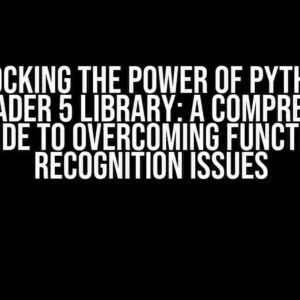Have you ever encountered the frustrating “Error: ‘list’ object has no attribute ‘split'” in Cloud Interpreter VSCode, only to find that the code runs smoothly when you input a string? You’re not alone! In this article, we’ll delve into the world of Python programming and uncover the reasons behind this error. Buckle up, folks, and let’s get started!
What is the ‘split’ method?
The ‘split’ method is a built-in Python function used to divide a string into a list of substrings. It takes one argument, the separator, which defaults to whitespace if not provided. The method returns a list of the split substrings. For example:
my_string = "hello world"
my_list = my_string.split()
print(my_list) # Output: ['hello', 'world']The Error: ‘list’ object has no attribute ‘split’
So, why do we get the “Error: ‘list’ object has no attribute ‘split'” when trying to use the ‘split’ method on a list object in Cloud Interpreter VSCode? Well, it’s quite simple, really. The ‘split’ method is a string method, not a list method. When you try to call ‘split’ on a list, Python gets confused and throws an error.
What’s going on in Cloud Interpreter VSCode?
In Cloud Interpreter VSCode, when you input a string, the code runs smoothly, and the ‘split’ method works as expected. But when you input a list, the error occurs. This is because Cloud Interpreter VSCode is designed to dynamically interpret Python code, and when you input a string, it’s treated as a string object. However, when you input a list, it’s treated as a list object, and the ‘split’ method is not applicable.
How to Fix the Error
So, how do you fix this pesky error? There are a few ways to do it:
Method 1: Ensure Input is a String
The simplest solution is to ensure that your input is a string. You can do this by using the `str()` function to convert your input to a string before applying the ‘split’ method.
my_input = input("Enter a string: ")
my_list = str(my_input).split()
print(my_list)Method 2: Check if Input is a List
If you’re not sure whether your input is a string or a list, you can use the `isinstance()` function to check the type of your input. If it’s a list, you can iterate over the list and split each element individually.
my_input = input("Enter a string or list: ")
if isinstance(my_input, list):
my_list = [str(i).split() for i in my_input]
else:
my_list = str(my_input).split()
print(my_list)Method 3: Use a Try-Except Block
If you’re feeling adventurous, you can use a try-except block to catch the error and handle it accordingly. This method is useful when you’re not sure what type of input you’ll receive.
my_input = input("Enter a string or list: ")
try:
my_list = my_input.split()
except AttributeError:
my_list = [str(i).split() for i in my_input]
print(my_list)Best Practices
To avoid this error in the future, follow these best practices:
- Always check the type of your input using `isinstance()` or `type()` before applying the ‘split’ method.
- Use the `str()` function to ensure your input is a string before applying the ‘split’ method.
- Handle potential errors using try-except blocks to ensure your code is robust and fault-tolerant.
Conclusion
In conclusion, the “Error: ‘list’ object has no attribute ‘split'” in Cloud Interpreter VSCode is a common issue that can be easily resolved by understanding the nature of the ‘split’ method and the input types. By following the methods and best practices outlined in this article, you’ll be well on your way to writing robust and error-free Python code. Happy coding!
| Method | Description | Code Snippet |
|---|---|---|
| Method 1: Ensure Input is a String | Use the `str()` function to convert input to a string before applying the ‘split’ method. | my_list = str(my_input).split() |
| Method 2: Check if Input is a List | Use the `isinstance()` function to check if input is a list, and iterate over the list to split each element individually. | my_list = [str(i).split() for i in my_input] |
| Method 3: Use a Try-Except Block | Use a try-except block to catch the error and handle it accordingly. | try: my_list = my_input.split() except AttributeError: my_list = [str(i).split() for i in my_input] |
Remember, in the world of Python programming, understanding the nuances of input types and methods is crucial to writing efficient and error-free code. Stay curious, keep learning, and happy coding!
Frequently Asked Question
Get the scoop on why your code runs smoothly in VSCode but throws an error in Cloud Interpreter!
Why does my code work in VSCode but not in Cloud Interpreter?
Ah-ha! It’s because VSCode runs your code locally, whereas Cloud Interpreter is a remote environment. Cloud Interpreter has more restrictive settings, which can cause issues like this. Make sure to check your code for any environment-specific dependencies or configuration issues.
Is the error “list object has no attribute split” specific to Cloud Interpreter?
Not entirely! This error can occur in any Python environment, not just Cloud Interpreter. The `split()` function is a string method, and if you’re trying to use it on a list object, you’ll get this error. VSCode might be more forgiving, but Cloud Interpreter is stricter, making it more likely to throw an error.
How can I fix the “list object has no attribute split” error in Cloud Interpreter?
Easy peasy! You need to ensure that you’re working with a string, not a list. Check your code and make sure you’re not accidentally converting a string to a list somewhere. If you’re reading input from the user, use `input()` instead of `list(input())`, and make sure to call `split()` on the resulting string.
Can I use a try-except block to handle the “list object has no attribute split” error?
You can, but it’s not the most elegant solution! A try-except block can help you catch the error, but it won’t fix the underlying issue. Instead, focus on identifying why you’re getting a list object in the first place and fix the root cause. If you’re unsure, try printing out the type of the object before calling `split()`. That’ll give you a hint about what’s going on!
Are there any best practices to avoid this error in the future?
Absolutely! To avoid this error, always verify the type of the object before calling a method. You can use `isinstance()` or `type()` to check if you’re working with a string or a list. Additionally, be mindful of how you’re reading input from the user, and make sure you’re not accidentally converting strings to lists. Finally, test your code thoroughly in different environments to catch any potential issues!





